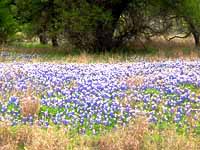Texas Plant Information Database

Overview
The Texas Plant Information Database (TPID) contains comprehensive information about native and a few selected naturalized plant species that have value for erosion control and wildlife use. It provides the user an opportunity to query and select species that have application for landscape enhancement or restoration. The selection of appropriate plants is based on specific site characteristics and management objectives.
This project is still evolving.Therefore, we welcome comments and suggestions. We hope the program is user-friendly as well as applicable. Species can be added to the database and modifications of existing data can be made where needed.In case there is a plant you would like to see added to the database, please e-mail the plant name to us at the address below. If the plant meets the criteria for addition to the database, a blank form will be mailed to you to fill out and send back.
Criteria for Including Plants in the Database TPID is based upon plants that have desirable characteristics and, when planted in appropriate associations, can provide vegetated landscapes similar to those that naturally occur in Texas. These plants include trees, shrubs, vines, forbs, grasses, and marsh plants. This database contains information on specific plants (e.g. wooly croton) as well as groups of plants (e.g. Croton spp.) for which data for several plants are grouped together.
Examples
Potential applications of TPID are numerous. Examples include:
Application:
Projects that disrupt large acreages (i.e., surface mines)
Land use conversion (from cultivation to conservation)
Vegetation manipulation (to improve floral diversity)
Dredge spoil deposition (to maintain Intercoastal Waterway)
Site Condition:
Vegetation removal and soil disturbance
Row crop farmland
Pure forest monoculture
Subsided coastal marsh
Management objective:
Wildlife habitat restoration
Restoration of native vegetation
Reintroduce hardwood species
Reclamation of marsh for stabilization and waterfowl habitat
Attribute Categories and Definitions
Some TPID attribute categories are self-explanatory, but others require specific definition to be understood by the user.
Distribution: The vegetational areas of Texas in which the plant is found (from Checklist of the Vascular Plants of Texas by Hatch, Gandhi, and Brown 1990).
Habitat/Site: Topographic Position (wet to dry sites); Aspect (geographic orientation toward preferred compass direction); Wetland Indicator (probability of occurrence in wetlands versus uplands according to the National List of Plant Species That Occur In Wetlands: Texas by Reed 1988).
Plant Characteristics: Seed Age (seed-bearing age for first seed set); Seed Interval (time span between seeding set); Growing Season (months of vegetative growth); Flowering Season (months of blooming); Fruiting Season (months of fruit availability).
Impact Characteristics (Economic/Ecologic): Short-term and Long-term Biomass Production (relative amount of standing plant matter exhibited at establishment [short-term] and at maturity [long-term]; Short-term and Long-term Pest Potential (evaluation for potential management problems based upon invasiveness, competitive ability, or spread after establishment [short-term] and at maturity [long-term]; Dominance (if dominant, has considerable influence on the numbers or distribution of other species at the site by means of its size, abundance, coverage, or persistence).
Erosion Control: Erosion Hardiness (ability to persist, i.e., to maintain erosion control after human or animal disturbance and after climatic adversity).
Soil Enrichment Characteristics: Soil Enrichment Potential (contributions to soil fertility or nutrient levels).
Propagation Characteristics: Seed, Cutting, and Transplant Success Potential: Low (lack of vigor, or complex preparation procedures involve expense, or extensive, long-term management required); Medium (moderate vigor, or preparation procedures involve moderate costs, or management requires one season to insure establishment; High (adequate vigor, or simple preparation procedures involve inexpensive costs, or little management required for establishment).
Associated Species: These are plants that may naturally associate together at a specific site. Distribution and habitat/site characteristics should be used to determine the selection of candidate species for a particular landscape.
Erosion Control Value Index: Calculated by the software program from the values assigned by the program (0-1-2-3) for particular plant species. Data attributes from which the index is calculated include values for Effectiveness Period, Raindrop Impact Prevention, Erosion Hardiness, Sheet and Rill Erosion Prevention, Ease of Propagation, Soil Binding Ability, and Relative Expense.The calculated value is converted to a ranking of 1 to 10, with 10 being most effective in erosion control.
Wildlife Use Value Index: Calculated by the software program from the values assigned by the program (0-1-2-3) for a particular plant species. Data attributes from which the index is calculated include both Wildlife Food and Cover Values for small mammals, large mammals, upland game birds, waterfowl, and nongame birds; Erosion Hardiness Value; Ease of Propagation Value, and Relative Expense Value. The calculated value is converted to a ranking of 1 to 10, with 10 being most valuable for use by wildlife.
Horticulture Information: TPID does not contain technical information on propagation, establishment, and maintenance. Such information is very site specific and detailed. Therefore, the user should consult the appropriate references and, for best results, obtain advice from knowledgeable local nursery personnel.